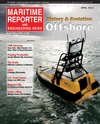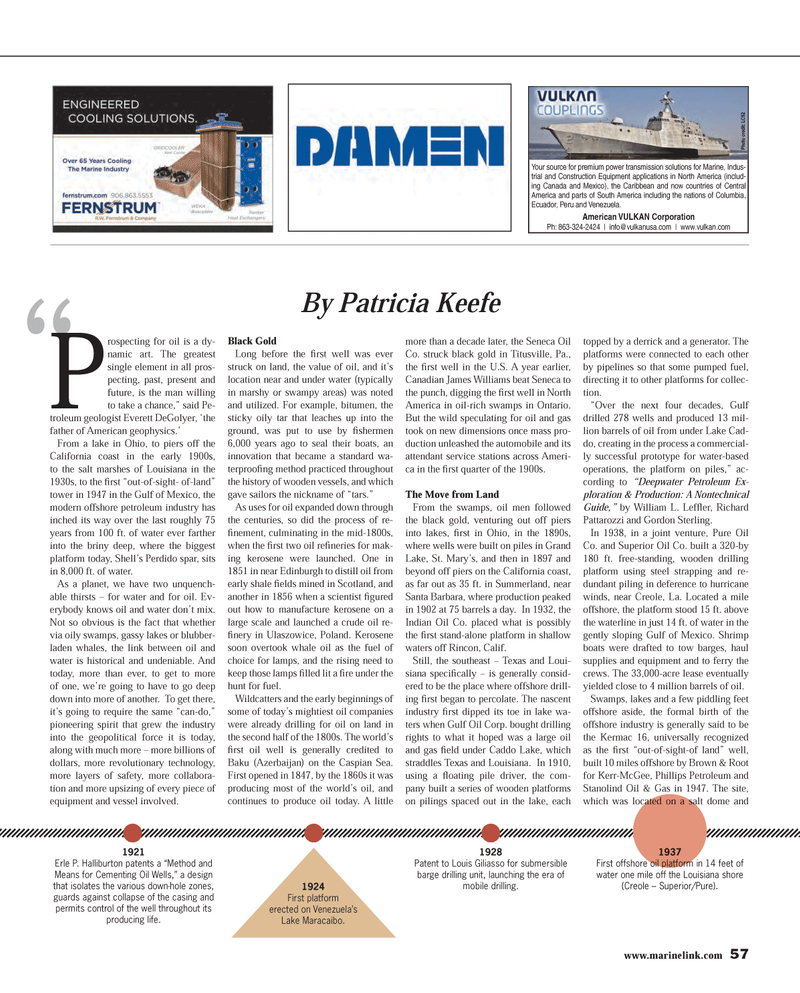
Page 57: of Maritime Reporter Magazine (April 2014)
Offshore Edition
Read this page in Pdf, Flash or Html5 edition of April 2014 Maritime Reporter Magazine
www.marinelink.com 57?American VULKAN Corporation Ph: 863-324-2424 | [email protected] | www.vulkan.com Your source for premium power transmission solutions for Marine, Indus- trial and Construction Equipment applications in North America (includ- ing Canada and Mexico), the Caribbean and now countries of Central America and parts of South America including the nations of Columbia, Ecuador, Peru and Venezuela. Photo credit: LCS2 American Vulkan MR Jan14.indd 112/19/2013 9:55:54 AM1921 Erle P. Halliburton patents a ?Method and Means for Cementing Oil Wells,? a design that isolates the various down-hole zones, guards against collapse of the casing and permits control of the well throughout its producing life. 1924 First platform erected on Venezuela?s Lake Maracaibo.1928Patent to Louis Giliasso for submersible barge drilling unit, launching the era of mobile drilling. By Patricia KeefeProspecting for oil is a dy-namic art. The greatest single element in all pros-pecting, past, present and future, is the man willing to take a chance,? said Pe-troleum geologist Everett DeGolyer, ?the father of American geophysics.? From a lake in Ohio, to piers off the California coast in the early 1900s, to the salt marshes of Louisiana in the 1930s, to the Þ rst ?out-of-sight- of-land? tower in 1947 in the Gulf of Mexico, the modern offshore petroleum industry has inched its way over the last roughly 75 years from 100 ft. of water ever farther into the briny deep, where the biggest platform today, Shell?s Perdido spar, sits in 8,000 ft. of water. As a planet, we have two unquench-able thirsts ? for water and for oil. Ev-erybody knows oil and water don?t mix. Not so obvious is the fact that whether via oily swamps, gassy lakes or blubber- laden whales, the link between oil and water is historical and undeniable. And today, more than ever, to get to more of one, we?re going to have to go deep down into more of another. To get there, it?s going to require the same ?can-do,? pioneering spirit that grew the industry into the geopolitical force it is today, along with much more ? more billions of dollars, more revolutionary technology, more layers of safety, more collabora- tion and more upsizing of every piece of equipment and vessel involved. Black GoldLong before the Þ rst well was ever struck on land, the value of oil, and it?s location near and under water (typically in marshy or swampy areas) was noted and utilized. For example, bitumen, the sticky oily tar that leaches up into the ground, was put to use by Þ shermen 6,000 years ago to seal their boats, an innovation that became a standard wa-terprooÞ ng method practiced throughout the history of wooden vessels, and which gave sailors the nickname of ?tars.? As uses for oil expanded down through the centuries, so did the process of re-Þ nement, culminating in the mid-1800s, when the Þ rst two oil re Þ neries for mak- ing kerosene were launched. One in 1851 in near Edinburgh to distill oil from early shale Þ elds mined in Scotland, and another in 1856 when a scientist Þ gured out how to manufacture kerosene on a large scale and launched a crude oil re- Þ nery in Ulaszowice, Poland. Kerosene soon overtook whale oil as the fuel of choice for lamps, and the rising need to keep those lamps Þ lled lit a Þ re under the hunt for fuel. Wildcatters and the early beginnings of some of today?s mightiest oil companies were already drilling for oil on land in the second half of the 1800s. The world?s Þ rst oil well is generally credited to Baku (Azerbaijan) on the Caspian Sea. First opened in 1847, by the 1860s it was producing most of the world?s oil, and continues to produce oil today. A little more than a decade later, the Seneca Oil Co. struck black gold in Titusville, Pa., the Þ rst well in the U.S. A year earlier, Canadian James Williams beat Seneca to the punch, digging the Þ rst well in North America in oil-rich swamps in Ontario. But the wild speculating for oil and gas took on new dimensions once mass pro-duction unleashed the automobile and its attendant service stations across Ameri- ca in the Þ rst quarter of the 1900s. The Move from Land From the swamps, oil men followed the black gold, venturing out off piers into lakes, Þ rst in Ohio, in the 1890s, where wells were built on piles in Grand Lake, St. Mary?s, and then in 1897 and beyond off piers on the California coast, as far out as 35 ft. in Summerland, near Santa Barbara, where production peaked in 1902 at 75 barrels a day. In 1932, the Indian Oil Co. placed what is possibly the Þ rst stand-alone platform in shallow waters off Rincon, Calif. Still, the southeast ? Texas and Loui- siana speciÞ cally ? is generally consid- ered to be the place where offshore drill- ing Þ rst began to percolate. The nascent industry Þ rst dipped its toe in lake wa- ters when Gulf Oil Corp. bought drilling rights to what it hoped was a large oil and gas Þ eld under Caddo Lake, which straddles Texas and Louisiana. In 1910, using a ß oating pile driver, the com- pany built a series of wooden platforms on pilings spaced out in the lake, each topped by a derrick and a generator. The platforms were connected to each other by pipelines so that some pumped fuel, directing it to other platforms for collec-tion. ?Over the next four decades, Gulf drilled 278 wells and produced 13 mil-lion barrels of oil from under Lake Cad-do, creating in the process a commercial-ly successful prototype for water-based operations, the platform on piles,? ac-cording to ?Deepwater Petroleum Ex- ploration & Production: A Nontechnical Guide,? by William L. Lef ß er, Richard Pattarozzi and Gordon Sterling.In 1938, in a joint venture, Pure Oil Co. and Superior Oil Co. built a 320-by 180 ft. free-standing, wooden drilling platform using steel strapping and re-dundant piling in deference to hurricane winds, near Creole, La. Located a mile offshore, the platform stood 15 ft. above the waterline in just 14 ft. of water in the gently sloping Gulf of Mexico. Shrimp boats were drafted to tow barges, haul supplies and equipment and to ferry the crews. The 33,000-acre lease eventually yielded close to 4 million barrels of oil. Swamps, lakes and a few piddling feet offshore aside, the formal birth of the offshore industry is generally said to be the Kermac 16, universally recognized as the Þ rst ?out-of-sight-of land? well, built 10 miles offshore by Brown & Root for Kerr-McGee, Phillips Petroleum and Stanolind Oil & Gas in 1947. The site, which was located on a salt dome and 1937First offshore oil platform in 14 feet of water one mile off the Louisiana shore (Creole ? Superior/Pure). MR #4 (56-65).indd 57MR #4 (56-65).indd 574/7/2014 3:13:00 PM4/7/2014 3:13:00 PM

 56
56

 58
58
